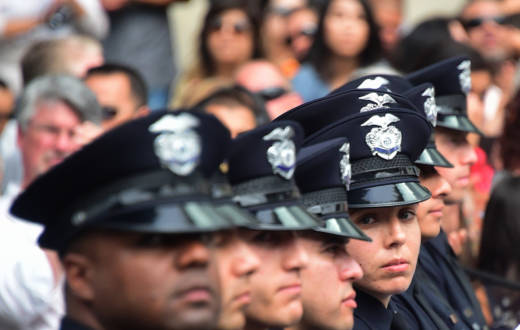Here are just some of the hundreds of programs and grants that could be cut, and the funding each got in 2016:
COPS Hiring Program Awards
City of Los Angeles: 25 police jobs, $3.1 million
City of Oakland: 15 positions, $1.8 million
DNA testing
14 jurisdictions, including San Francisco, Alameda, Contra Costa, Los Angeles and San Diego received $5.6 million in FY2016 for DNA testing and help going through the backlog.
Body-worn cameras
California state and local municipalities received more than $1 million for body worn cameras in 2016.
COPS Anti-Methamphetamine Program
California got $1.4 million in 2016 for this program.
UC Regents: Investigating short- and long-term impacts of mass violence
The UC Regents received a $1.75 million grant in 2016 to investigate the impacts of mass violence.
Internet Crimes Against Children task force
San Jose received $150,000 in 2016 for this task force.
Back up — are these cuts actually going to happen?
According to Johnson, dean of the UC Davis Law School, that remains to be seen. There’s no real definition of what a sanctuary city is, he says, meaning there’s no real congressional authorization for cutting funding to those cities.
Also, the city of San Francisco filed a lawsuit in late January against President Trump and his administration, charging that Trump’s order to strip funding from sanctuary cities amounts to an invasion of the city’s sovereignty — a violation of the 10th amendment.
Experts also say that the federal government needs to define at what point they would cut off funds.
Daniel Stageman, director of research operations at the John Jay College of Criminal Justice, says that all jurisdictions communicate with ICE to some degree.
Also, not all jurisdictions refuse to hold people for ICE because they’re a sanctuary city, but often because they’re afraid of being sued for detaining someone illegally, Stageman said.
So would jurisdictions that hold people for two hours for ICE lose funding? Or jurisdictions that hold people for 24 hours? Or not at all?
That’s why this case is likely to make it to the Supreme Court, Johnson says.
What’s an example of how these potential cuts could have an actual impact?
“This is broad, this is a lot.” says Stageman, who studies the federal grants, “this could affect boots on the ground.”
Stageman says some of the funds pay for the first year of new police officers: The City of Oakland got nearly $2 million to hire 15 new police officers in 2016; the City of Los Angeles received $3 million for 25 new officers.
That may not sound like a lot, but every body counts, says Craig Lally, president of the Los Angeles Police Protective League.
“We don’t have enough police officers now, and we struggle every day to put enough officers in the field, just to handle simple 911 calls,” he says. “It’s becoming very tough for your average officer out there.”
Is there any way that a sanctuary city, like San Francisco, could keep its declared status as a sanctuary city but still get the federal funding?
Yes, Johnson says. One possibility is a voluntary agreement, also known as 287(g). It’s something that Trump is encouraging. It allows state and local governments to outline designated roles with the federal government when it comes to immigration. Some cities have entered into these kinds of agreements. These agreements are one way of trying to work out some of these tense areas with the federal government. Orange County is the only jurisdiction with a 278(g) agreement in California.
KQED’s Miranda Leitsinger, Penny Nelson, Lisa Pickoff-White, Scott Shafer and Julie Small contributed to this report.

